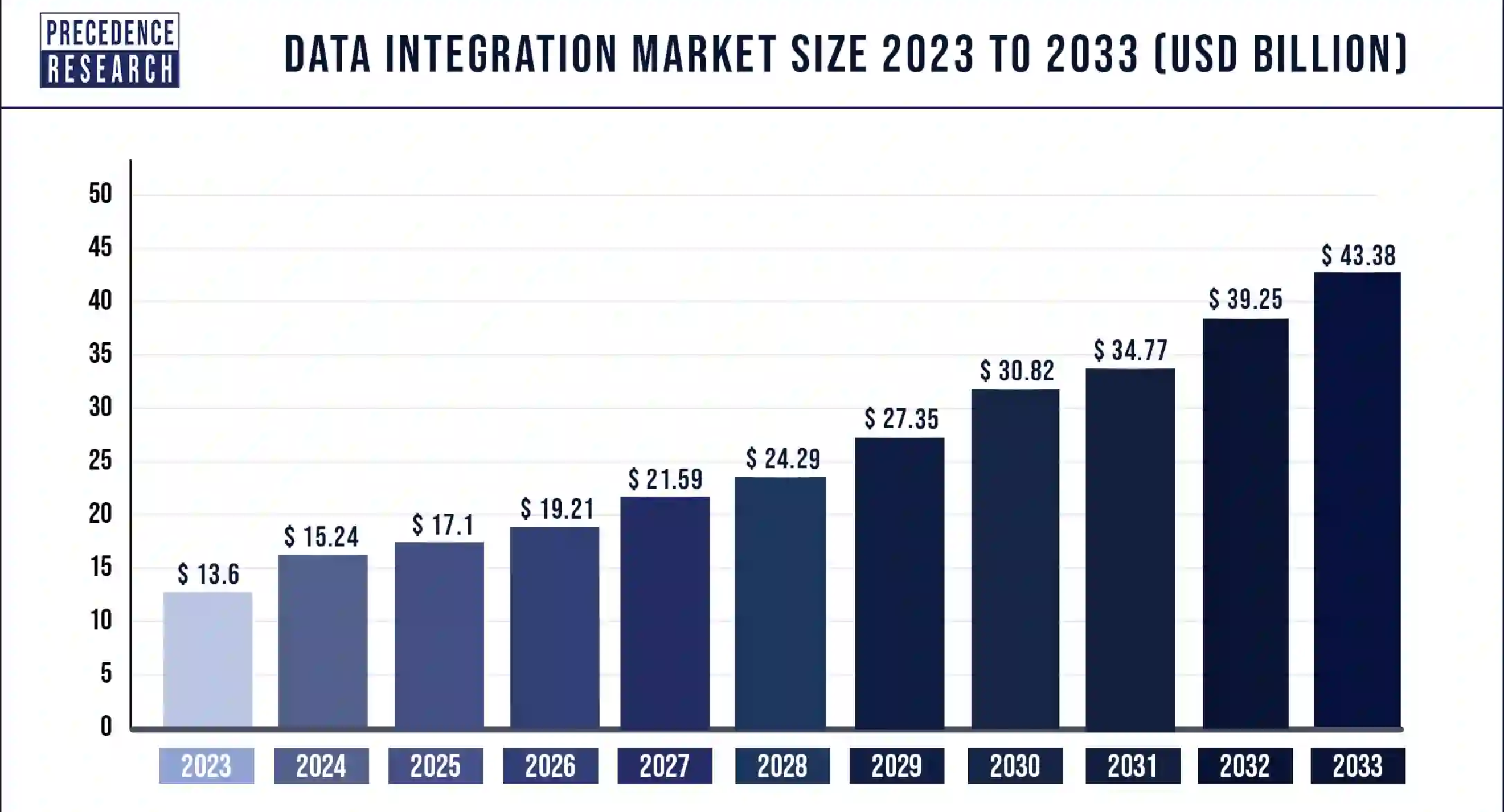Businesses today can have access to a wealth of data collected from internal records (database, CRM, etc.) to external sources (social media, industry websites, etc.). Leveraging this data can be a potent tool for scaling and growing your company. However, as an entrepreneur, you must first understand how to employ data integration.

This page shares what you need to know about data integration, including what methods to choose and tools to use.
Table of contents:
What Is Data Integration?
Key Benefits of Data Integration
Don’t Get Drown in Data
What Is Data Integration?
Data integration is the process of gathering and unifying data from multiple sources into a cohesive, usable format. This process lets you analyze information using tools or platforms, make decisions, and act more efficiently and effectively.
It can impact your business operations enormously. Think of data-driven digital marketing and sales strategies, for example. As an online marketer, you can leverage customer relationship management (CRM) platforms to manage consumer data and make campaign decisions.
Data integration started in the 1980s when companies saw the value of data consolidation in one place. To be precise, while the 1980s weren't the absolute beginning of the concept, it was a turning point where data integration became more feasible and valuable for businesses.
Its main pillars were:
- Data Warehousing: storing data from various sources in a single repository for data analysis and business reporting.
- Extract, Transform, and Load (ETL): collecting data from multiple sources, transmitting it in a standardized format, and storing it in a database.
- Data Lakes: recording and storing big data (raw and unstructured information) for analysis and reporting.
But with the advent of technology, data integration has become more seamless, accurate, and efficient than before.
Past few years we have seen the rise of cloud computing, the Internet of Things (IoT), and artificial intelligence (AI), making data access, management, and analysis much easier, faster, and better.
Precedence research now predicts the global data integration market to grow from $13.6 billion in 2023 to $43.38 billion by 2033. It’s forecasted to expand at a 12.32% compound annual growth rate (CAGR).

Learn more about the various methods and digital tools used for data integration below.
Data Integration Methods
There are several approaches you can take. Below are the four common methods:
- Manual Integration involves collecting and cross-referencing data without using digital tools or applications. This method is low-cost but time-consuming and not scalable.
- Common Data Storage (CDC) entails copying data from sources and storing it in a central location. Also known as data warehousing, CDC provides analytics but can raise data quality issues.
- Uniform Data Access Integration (UDAI) allows you to compile data into a uniform, readily accessible state without a separate data store. UDAI is suitable for small and similar data sets.
- Middleware Integration enables you to use software to connect applications and facilitate data transfer within a network. This method is best for improving accessibility and translating data between systems.
Selecting the Right Integration Method
Companies use data warehouses and applications to process information. Suppose you operate a lending agency needing to manage good and bad debts without compromising consumer data and financial information. In this case, you choose the best data integration method to record, process, and protect critical information.
“The right data integration approach depends on your business needs and data sources. Implementing the incorrect strategy might increase employee workload, reduce business productivity, and prevent scalability. Therefore, using the right method is key to a successful integration.” Tony Mariotti, CEO of RubyHome
Tony Mariotti recommends these factors to consider:
- The number and variety of data sources.
- The need for real-time data access.
- The required level of data quality and consistency.
- Budget and IT resource constraints.
Choosing the Right Integration Tools
Implementing data integration methods is one thing; leveraging the right tools or platforms is another.
Big companies or large corporations use an average of 175 applications within their organization! However, choosing the right technology is key to effective data integration and business optimization.
As mentioned, you can gather data from:
- Internal sources (database, CRM platform, business website, etc.)
- External sources (social media, industry research, public datasets, etc.)
Meanwhile, you can collect data through:
- Data collection strategies: Think of implementing web analysis, social media monitoring, online surveys, etc.
- Data collection tools: Consider using data analytics, predictive analytics, IoT devices, etc.
But when selecting data integration software, consider critical factors like:
- Compatibility with your existing systems and data sources.
- Ease of use and implementation.
- Scalability to accommodate future growth.
- Robust data security and governance features.
Learn more about how data integration can help scale your business in the next section.

Key Benefits of Data Integration
Now, it’s time to see how data integration can optimize a business. Companies may employ middleware integration and use a CRM system to process clean and up-to-date data. However, why is this necessary?
Implementing effective data integration provides you with the following benefits:
1. Eliminate Labor-Intensive Processes
Many projects fail due to poor data quality. This usually happens due to tedious and cumbersome data processing done manually. Automating data integration frees your employees to focus on higher-value tasks, helping your business keep pace with customer demands.
Grant Aldrich, Founder of Preppy, highlights the value of data integration platforms with automation features.
Aldrich says, "Your company needs to create seamless processes to maintain customer satisfaction and encourage repeat business. Without analyzing important data, you cannot strengthen customer relationships and improve the customer experience."
2. Remove Data Silos
Data silos happen when information gets isolated in separate departments. They can hinder communication, efficiency, and productivity in your company. Integrating data into a centralized, accessible format empowers cross-functional collaboration and decision-making.
Sturgeon Christie, CEO of Second Skin Audio, underscores the importance of data integration for effective communication and collaboration.
Christie argues, "Data silos prevent a business from conducting operations and tasks efficiently. Isolated data damages communication, which could be fatal for your business looking to grow and succeed. Breaking down these barriers through data integration helps foster effective collaboration."
3. Streamline Data Transformation
Manual data transformation is time-consuming and prone to errors. Integration software
automates this process, refining raw data into a quality, functional format. That's the beauty of data integration using digital tools and technologies.
Albert Kim, VP of Talent at Checkr, explains, "Hand-coded data integrations are lengthy and time-consuming. Not only are they laborious, but they can also impact business productivity and profitability. Investing in a reputable data integration platform will ensure your company is capable of outperforming competitors in your industry."
4. Gain Actionable Insights
Data is crucial in business. However, according to a survey by Deloitte, more than half of CFOs pointed to inadequate technologies/systems, immature capabilities, and lack of experienced talent as their greatest roadblocks in driving data to insights.
"Valuable data can help you make better business decisions that could substantially improve your ROI. But you need to invest in a reputable data integration platform. You'll be then amazed how data insights can bring more and more money to your business." Brooke Webber, Head of Marketing at Ninja Patches
Don't Get Drowned in Data
To summarize, integrating data from all available sources is crucial for business growth and success. But why is there a need to do so?
Here's how data integration helps you scale:
- The integration allows for clear and actionable insights.
- No more waiting for reports. Make data-driven decisions faster.
- As your company grows, so will your data. Integration ensures a smooth and scalable foundation.
If you face data integration challenges, here are some actionable steps to consider:
1. Start with a clear strategy
Define your goals. What data do you need, and how will it improve decision-making?
2. Invest in the right tools
Choose solutions that fit your needs and technical capabilities.
3. Build a data-driven culture
Foster a company culture that values data insights. Train employees on understanding and utilizing data effectively.











